A picture guide to help identify 'high flying' summer woodland butterflies found in Hertfordshire and Middlesex |
||||||
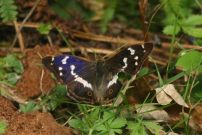 |
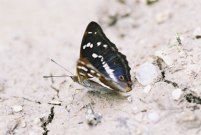 |
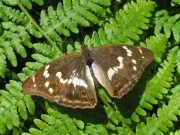 |
||||
| Male Purple Emperor Apatura iris |
Female Purple Emperor |
|||||
| Purple Emperors occur mainly in July in or near old woodland, that has plenty of sallow/willow nearby. The Purple Emperor may be seen gliding between gaps in the tree canopy. Sometimes it's seen collecting salts from the ground or from 'waste matter.' Although both males and females can both appear dark, the upperwings of the male can refract a purple sheen when seen at a some angles | ||||||
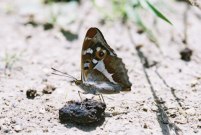 |
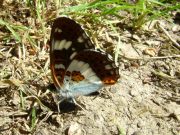 |
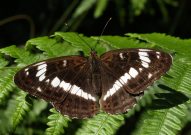 |
||||
| Purple Emperor Apatura iris |
White Admiral Limenitis camilla |
|||||
| The underwing of a Purple Emperor - It uses its yellow proboscis to feed on aphid honeydew and to take salts. The Purple Emperor does not normally nectar at flowers but there have been a few observations. | The general colours and patterns of the White Admiral are not unlike those of the Purple Emperor. A high-flying Purple Emperor could easily be passed off as a White Admiral during casual observations, although the White Admiral is rather smaller and has a more rounded wing-shape. White Admirals can be seen mainly from late June to mid July in older woods that have plenty of honeysuckle. Like Purple Emperors, they glide in and out of the canopy and also feed on aphid honeydew in the tree-tops, but they are more often seen visiting flowers and bramble-banks lower down. | |||||
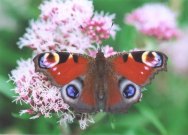 |
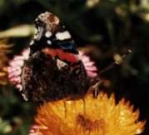 |
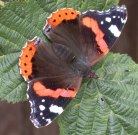 |
||||
| Peacock Aglais io |
Red Admiral Vanessa atalanta |
|||||
| The Peacock appears large and dark when seen in flight. Although very common in gardens this butterfly is also seen flying and nectaring in woodland especially along sunny rides. The new generation appears from around mid July, but sometimes goes into hibernation almost immediately | The Red Admiral is a large and distinctive butterfly, only a little smaller than a Purple Emperor. It can be seen throughout the summer in many places including woodlands and gardens. The butterfly will be seen feeding on nectar, but will also take salts from 'waste matter' | |||||
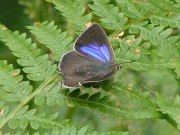 |
Purple Hairstreak Favonius quercus © photo: Andrew Middleton right A much smaller butterfly that also feeds on aphid honeydew. Seen mainly in July,and especially on oak and ash leaves. The best time to see this buttefly is late afternoon/early evening |
|
||||